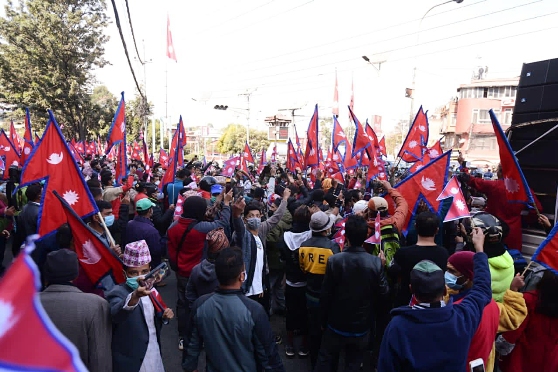Nepal in political reverse gear
As monarchy looks to make a comeback
By P. K. Balachandran
The Nepalese monarchy, based on the Hindu king’s divine right to rule, was overthrown in 2008 following a long movement that was partly peaceful and partly violent. The country eventually got a secular, federal and democratic constitution under which a communist regime has been in existence since 2018.
It all began very well. After the monarchy was abolished, the Maoists gave up their 20-year armed struggle in 2016 and joined the mainstream. Then there was constitution making resulting in a federal system, which in turn led to the General Election of 2017. An alliance of the then Communist Party of Nepal (United Marxist Leninist) led by K.P. Sharma Oli and the Communist Party of Nepal (Maoist Centre) led by Pushpa Kamal Dahal alias Prachanda won. The two formed a united party called Nepal Communist Party (NCP), which has been in power since.
However, the democratic experiment has shown many warts. Political instability has been endemic and the economic situation, made worse by the COVID-19 pandemic, has been adding to the woes of the people. Nepal also appears to be under the pressure of foreign powers, principally India and China, due to the exacerbation of geo-political rivalry following China’s meteoric rise as a regional power. The result has been a growing public demand for a return to the monarchy.
In November, masses of people disregarded COVID restrictions to rally in Kathmandu and other towns, demanding the restoration of the Hindu theocratic monarchy. On November 10, the ‘Nationalist Civic Society’ staged a demonstration in Jamal of Kathmandu, demanding restoration of constitutional monarchy and the declaration of Nepal as a Hindu state. Two days later, the ‘Nepal Scholars Council’ demonstrated in Biratnagar with the same demands. On November 19, the ‘Independent Nationalist Citizens Far-West’ demonstrated in Dhangadhi followed by a protest in Pokhara on November 25 under the banner ‘Western Nepali Citizens’. The ‘Nepal Nationalist Group’ demonstrated in Janakpur. On November 29 and 30, there were demonstrations by the ‘Restoration of Constitution Movement’ in Kathmandu. Protestors displayed placards bearing pictures King Prithivi Narayan Shah, who founded the Shah dynasty that ruled from 1768 to 2008.
The reason for wanting to put the country in political reverse gear is the comprehensive and manifest failure of the democratic political system to deliver on its promises, irrespective of the party or leader in power, observers of Nepalese politics say. Instability is endemic. Nepal has so far had 22 changes in the premiership in 70 years.
Nepalese political culture has been vitiated by persistent factionalism based on an unbridled pursuit of personal power. Factionalism is so intense that governments have come down not due to pressure from the opposition but infighting in the ruling party or coalition. As in the past, if the current beleaguered prime minister eventually goes, he would be doing so due to a split in the ruling party Nepal Communist Party (NCP) and not due to the opposition, which is equally split.
In addition, there has been a burgeoning fear among the Nepalese of losing their traditional independence from great power interference due to the non-existence of a strong domestic unifying force. As the veteran Nepalese commentator Yubaraj Ghimire put it: “There is a feeling that the monarchy had ensured Nepal’s independence and sovereignty. Hence the demand for its restoration.”
It appears that the deposed monarch, Gyanendra, is toying with the idea of coming back to power as king. He told Reuters as early as in 2016 that it was time Nepal was saved from political instability. Indeed, Nepal had maintained its independence under its monarchs.
Nepal was the only country in the Indian sub-continent that did not come under British rule in colonial times, even after its defeat in the two-year Anglo-Nepalese war (1814 to16). The British did not take over Nepal after their victory but only posed an ambassador. China too did not eye Nepal even though it was enjoying over-lordship in neighbouring Tibet.
As in the past, current Prime Minister Oli is unable to get along with Prachanda, who is the co-chairman of the ruling the NCP. Prachanda has been demanding that Oli hold only one post and consult the NCP Standing Committee before taking decisions as prime minister. But Oli would not oblige. Knowing that his faction is in a minority in the Standing Committee, Oli has been refusing to call a meeting of the Committee and instead settled for an all-party meeting to get advice on how to tackle national problems. The meeting was fruitless. Oli did not acknowledge his mistakes even as party leaders went hammer and tongs against his government.
“All the party leaders speaking at the all-party meeting had lashed out at the government’s failure on all fronts including proper implementation of the Constitution,” Janak Raj Sharma, general secretary of the Rastriya Janamorcha told Kathmandu Post. Nepalese commentators said the opposition parties too had failed.
In the meanwhile, the home ministry issued directives to 77 districts to quell the current spate of protests, through force, if needed. While the Oli regime may be able to control agitations, it may find it hard to solve the economic problems created or aggravated by the on-going pandemic, which has claimed more than 1500 lives.
-P K. Balachandran is a senior Colombo-based journalist who in the past two decades, has reported for The Hindustan Times, The New Indian Express and the Economist


